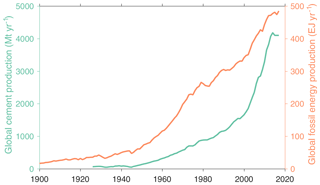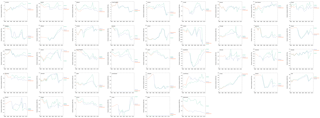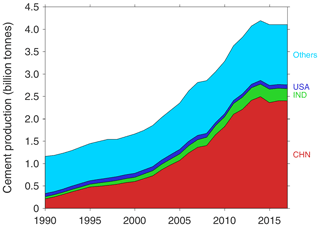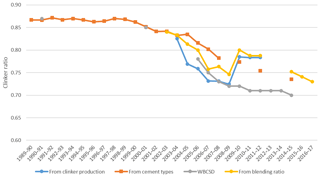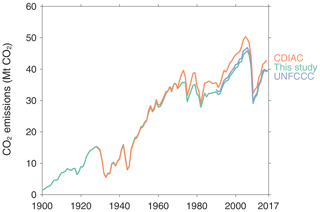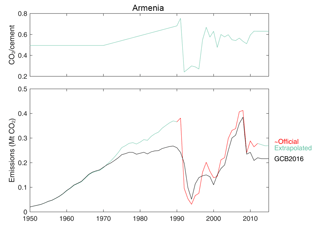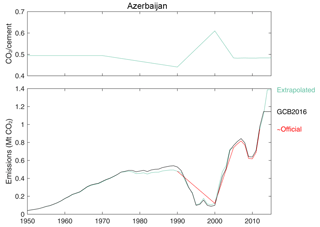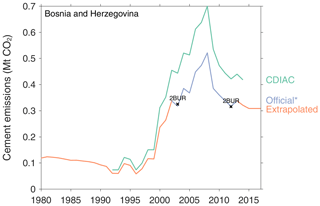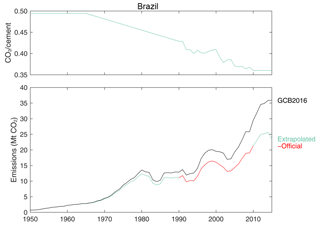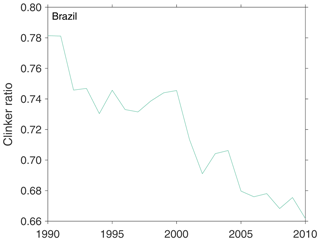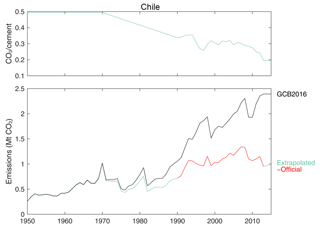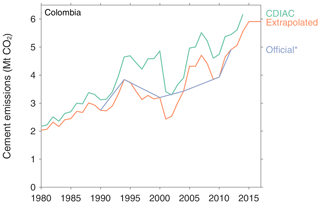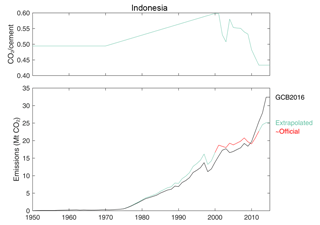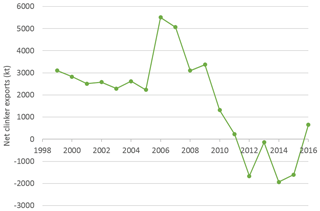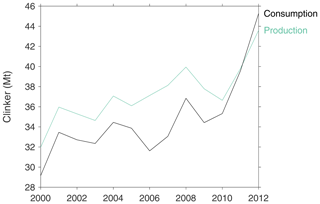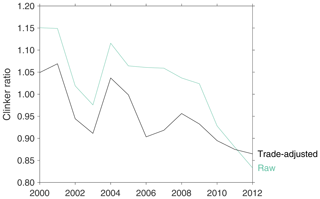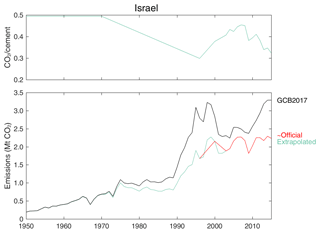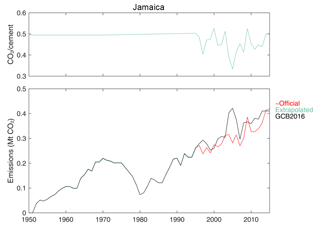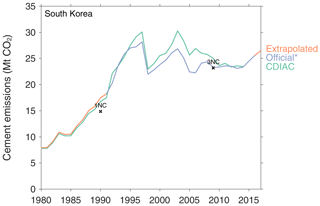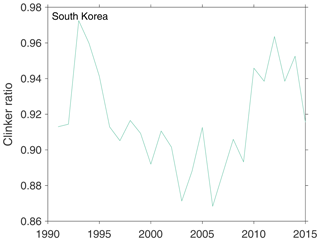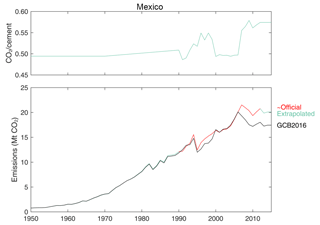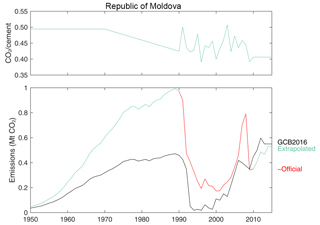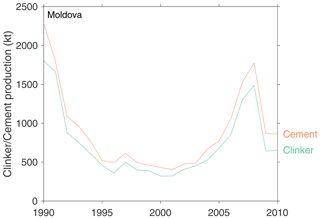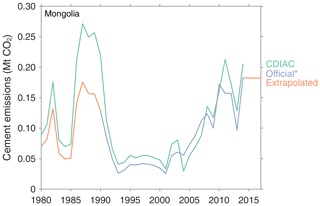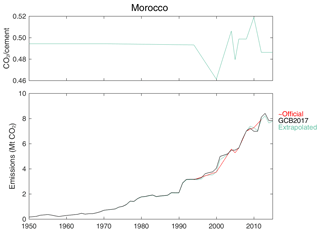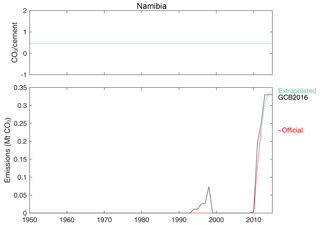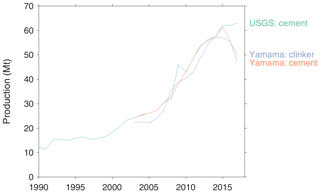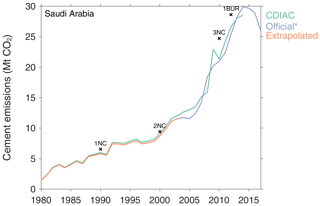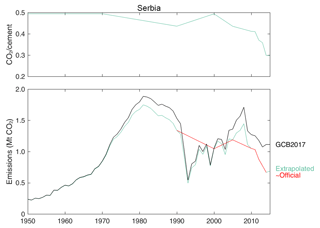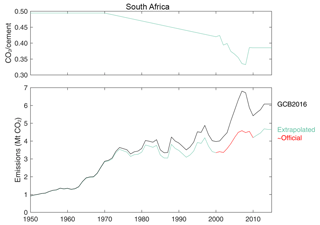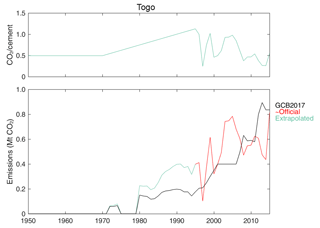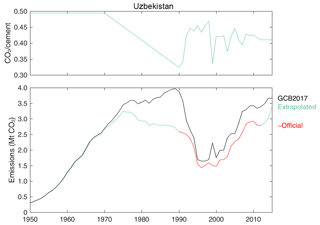the Creative Commons Attribution 4.0 License.
the Creative Commons Attribution 4.0 License.
Global CO2 emissions from cement production, 1928–2017
Global production of cement has grown very rapidly in recent years, and after fossil fuels and land-use change, it is the third-largest source of anthropogenic emissions of carbon dioxide. The availability of the required data for estimating emissions from global cement production is poor, and it has been recognised that some global estimates are significantly inflated. Here we assemble a large variety of available datasets, prioritising official data and emission factors, including estimates submitted to the UNFCCC plus new estimates for China and India, to present a new analysis of global process emissions from cement production. We show that global process emissions in 2017 were 1.48±0.20 Gt CO2, equivalent to about 4 % of emissions from fossil fuels. Cumulative emissions from 1928 to 2017 were 36.9±2.3 Gt CO2, 70 % of which have occurred since 1990. Emissions in 2016 were 28 % lower than those recently reported by the Global Carbon Project. The data associated with this article can be found at https://doi.org/10.5281/zenodo.831454.
- Article
(4974 KB) - Full-text XML
- Version 1928–2016
- BibTeX
- EndNote
Anthropogenic emissions of carbon dioxide to the atmosphere come from three main sources: (i) oxidation of fossil fuels, (ii) deforestation and other land-use changes, and (iii) carbonate decomposition. Cement – the largest source of emissions from decomposition of carbonates – is a binding material that has been used since ancient times, but it was following World War II that the production of cement accelerated rapidly worldwide, with current levels of global production equivalent to more than half a tonne per person per year (Fig. 1). Global cement production has increased more than 30-fold since 1950, and almost 4-fold since 1990, with much more rapid growth than global fossil energy production in the last 2 decades. Since 1990 this growth is largely because of rapid development in China, where cement production has grown by a factor of more than 11, such that 75 % of global growth in cement production since 1990 occurred in China.
There are two aspects of cement production that result in emissions of CO2. First is the chemical reaction involved in the production of the main component of cement, clinker, as carbonates (largely CaCO3, found in limestone) are decomposed into oxides (largely lime, CaO) and CO2 by the addition of heat. These emissions (E) can be calculated as follows:
where is the molecular weight of CO2, the molecular weight of CaO, the fraction of CaO in clinker, the fraction of clinker in cement (the “clinker ratio”), and Mcem the mass of cement (see Appendix A for details). Recent estimates are that these so-called “process” emissions contribute about 5 % of total anthropogenic CO2 emissions excluding land-use change (Boden et al., 2017).
The second source of emissions is from the combustion of fossil fuels to generate the significant energy required to heat the raw ingredients to well over 1000 ∘C, and these “energy” emissions, including those from purchased electricity, could add a further 60 % on top of the process emissions (IEA, 2016). Total emissions from the cement industry could therefore contribute as much as 8 % of global CO2 emissions. These process (sometimes “industry” or “industrial process”) and energy emissions are most often reported separately in global emissions inventories (Eggleston et al., 2006; Le Quéré et al., 2018).
The Global Carbon Project annually publishes estimates of global emissions of CO2 from use of fossil fuels and cement production, and these estimates are used by the global carbon modelling community as part of development of the Global Carbon Budget (Le Quéré et al., 2018). It is therefore important that the emissions estimates are as accurate as possible. This emissions database covers all emissions of CO2 resulting from oxidation (not only energy use) of fossil fuels, including those that occur in the IPCC sector “Industrial Processes and Product Use”, such that including cement emissions means that the vast majority of CO2 emissions are covered.
In this work we investigate the process emissions from cement production and develop a new time series for potential use by the Global Carbon Project, and present plans for future continued updates, revisions, and development. The focus on process emissions here is because both direct fossil fuel emissions and electricity emissions are already accounted for in other parts of the Global Carbon Budget.
Cement, is the molecular weight of CO2 (44.01), and is the molecular weight of CaO (56.08). Based on discussion with experts, Griffin (1987) recommended that , calculated as the midpoint of the range 0.60–0.67 given by Orchard (1973).
According to the IPCC's most recent 2006 guidelines (Hanle et al., 2006), when using cement production data adjusted for clinker trade, the formula should read as follows:
where is the clinker ratio, and is the fraction of CaO in clinker.
Early estimates of emissions from global cement production effectively assumed that almost all cement was of the ordinary Portland cement (OPC) type, which uses a very high proportion of clinker and very small amounts of other ingredients, such as gypsum to control setting time. For at least the first half of the twentieth century this assumption was quite reasonable, with the vast majority of cement being produced in industrialised countries, which followed carefully developed and tested standards regarding strength and other important qualities.
In 1970, Baxter and Walton presented estimates of global CO2 emissions from fossil fuels and cement production for 1860–1969, where the “mean calcium oxide content of cements was taken to be 60 % …and the carbon content of limestone assumed to be 12 % with 100 % kilning efficiency (Baxter and Walton, 1970). Thus the …manufacture of 1 tonne of cement yields …4.71×105 g of carbon dioxide…” (i.e. 0.471 t CO2 (t cement)−1. Assuming their estimate of global cement production in 1969 was the same as that reported by the USGS (2014), their estimate of emissions from cement production in 1969 would have been 256 Mt CO2.
In a landmark paper of 1973, Charles Keeling presented a systematic analysis of emissions from fossil fuel combustion for 1860–1969 and cement production for 1949–1969 (Keeling, 1973). Using an average CaO content of cement of 64.1 %, Keeling's emission factor was 0.50 t CO2 (t cement)−1, giving an estimate for emissions from cement production in 1969 of 272 Mt. While both Keeling (1973) and Baxter and Walton (1970) cited Lea and Desch (1940) as the source for their estimates of the CaO content of cement, they nevertheless used different fractions. Importantly, these fractions were assumed to be time-invariant.
Marland and Rotty (1984) presented further estimates for 1950–1982, using a global average CaO content of cement of 63.8 %, taken directly from US data for 1975. From this they derived a time-invariant emission factor of 0.50 t CO2 (t cement)−1.
The estimates made by Marland and Rotty (1984), combined with the earlier estimates of Keeling (1973) were included in the archive of the Carbon Dioxide Information Analysis Center (CDIAC) in 1984 (Rotty and Marland, 1984). Later, CDIAC modified the cement emission factor very slightly based on a study by Griffin (1987), who (in turn based on Orchard, 1973) said that “the range of lime [CaO] content in cement is 60–67 percent” and, based on discussion with experts, recommended the use of 63.5 %, calculated as the midpoint of the range (Boden et al., 1995). This time-invariant, global emission factor of about 0.50 was still in use in CDIAC's 2016 data release.
CDIAC's method was directly adopted by the Intergovernmental Panel on Climate Change (IPCC) in their 1996 guidelines (Haukås et al., 1997) in the case where clinker production data were not available. The IPCC subsequently revised its methods in the case, where clinker production are not available, in the 2006 guidelines (p. 10):
in the absence of data on carbonate inputs or national clinker production data, cement production data may be used to estimate clinker production by taking into account the amounts and types of cement produced and their clinker contents and including a correction for clinker imports and exports. Accounting for imports and exports of clinker is an important factor in the estimation of emissions from this source.
In addition, the IPCC guidelines now recommend inventory compilers use of a default clinker ratio of 0.75 when it is known that significant amounts of blended cements are produced in their country.
The Emissions Database for Global Atmospheric Research (EDGAR) presents estimates of CO2 and other climate-important gases by country. For cement they initially used the emission factor from Marland and Rotty (1984) of 0.50 t CO2 (t cement)−1 (Olivier et al., 1999). With the release of version 4.1 of the database in 2010, they modified their emission factor to account for changing rates of blending (i.e. lower clinker ratios) in cement production in response to work by the World Business Council for Sustainable Development (WBCSD), who released sample-based estimates of the clinker ratio in a range of countries (Janssens-Maenhout, 2010). In version 4.3.2, EDGAR used official estimates from Annex-I parties to the UNFCCC, specific clinker production data for China, and the WBCSD database for all remaining countries (Olivier et al., 2016; Janssens-Maenhout et al., 2017).
Since 2003, countries that are listed in Annex 1 of the UN Framework Convention on Climate Change (UNFCCC) have submitted annual inventories of greenhouse gas emissions in considerable detail, including estimates of emissions from cement production (UNFCCC, 2018). Other parties to the convention are requested to submit less detailed and less frequent National Communications and, more recently, Biennial Update Reports (BURs).
While cement production data are available by country (van Oss, 1994–2018), it is production of clinker that leads to process CO2 emissions, and the amount of clinker in cement varies widely. With no available source of clinker production data for all countries, other options must be considered. The direct use of cement production data without adjustment for clinker ratios that vary by country and over time, or for clinker trade, leads to poor emissions estimates (see Appendix A), and should therefore be used only as a last resort. The World Business Council for Sustainable Development (WBCSD), through its “Getting the Numbers Right” initiative, has collected cement data, including clinker production data, directly from firms, but their survey-based approach leaves many parts of the world poorly sampled (WBCSD, 2014).
The main rationale of our approach, therefore, is to prioritise officially reported emissions, recognising that these generally make use of data and knowledge unavailable elsewhere; then we use officially reported clinker production data and emission factors; then IPCC default emission factors; then industry-reported clinker production; and finally survey-based clinker ratios applied to cement production data (Appendix B), where no better data are available. Full details are provided in Appendix D and in the associated data files.
For the 42 Annex-I countries that report their greenhouse gas inventories annually to the UNFCCC, we extract official estimates of cement-production emissions from 1990 onwards. Some Eastern European countries submit data for years before 1990: Poland and Bulgaria from 1988, Hungary from 1986, and Slovenia from 1987. These are all based on clinker production data and largely use Tier-2 methods (the middle level of detail; Hanle et al., 2006). This dataset covers about 10 % of current global cement production, and is available as consistently structured spreadsheet files for each year. In addition, clinker production data were available for the US from 1925 (Hendrik van Oss, USGS, personal communication, 2015).
Some non-Annex-I parties have begun to include time-series of cement emissions in their National Communications, National Inventory Reports, and Biennial Update Reports to the UNFCCC, and these estimates have been used directly. At the time of writing, the following countries reported useable time-series data: Armenia, Azerbaijan, Bosnia and Herzegovina, Brazil, Chile, Colombia, Indonesia, Israel, Jamaica, Lebanon, Mexico, Moldova, Mongolia, Morocco, Namibia, Serbia, South Africa, Togo, and Uzbekistan. In addition, Brunei Darussalam, Côte d'Ivoire, Mauritania, Sierra Leone, and Tuvalu report that all of their clinker is imported.
For China, which currently produces almost 60 % of global cement, clinker production data are available from 1990. China's emission factor is reported by NDRC (2014) as 0.5383 t CO2 (t clinker)−1, and this is used both in the second National Communication (NDRC, 2012) and the first Biennial Update Report (NDRC, 2016). Some studies have estimated other emission factors based on factory-level sampling (Liu et al., 2015; Shen et al., 2014), but here we use the officially sanctioned factor until or unless that is changed.
India, the world's second-largest cement producer, with about 7 % of global production in recent years, does not officially report clinker production statistics. Data from the Cement Manufacturers' Association (CMA) are useful only until the 2009/2010 financial year, when two large producers discontinued membership of the organisation (CMA, 2010). Clinker production data are also reported by business consultancies in their annual overviews of the industry in India. Data on the types of cement produced, combined with their likely clinker contents, can also be used to support this evidence base.
While Jamaica reported cement emissions for 2006–2012, the data source was clearly identified and additional clinker production data have been obtained to cover 1995–2016. Meanwhile, clinker production data for the Republic of Korea were readily available from its Cement Association for 1991–2016; emissions estimates from these data matched those reported in official communications to the UNFCCC during overlapping periods. Clinker production data were also available for Saudi Arabia from one of its cement manufacturers for 2003–2017.
Finally, for all remaining countries we have used survey-based clinker-ratio data from the WBCSD's Getting the Numbers Right initiative (WBCSD, 2014), combined with historical cement production data from the USGS. In many cases these clinker ratios are presented only for groups of countries, but nevertheless represent the best available information about clinker ratios in those countries.
Most of these methods provide estimates only back to 1990 at best, and we therefore extrapolate for earlier years using cement production data combined with assumptions about how clinker ratios have changed over time. We make the basic assumption that most countries began their cement industries by producing ordinary Portland cement, a strong and very common cement type with a clinker ratio of 0.95, and over time introduced other types of cements with lower clinker ratios. This assumption reflects available observations. Specifically, the clinker ratio was set to 0.95 in 1970, with the IPCC default emission factor, and linearly interpolated to the implied ratio and emission factor in the earliest year for which data are available for each country. For large cement producers, covering more than 80 % of global production, USGS provides an estimate of cement production for 2017 (USGS, 2018), and these are used to estimate 2017 emissions for those countries. For other countries emissions are assumed to be the same as in 2016. While this extrapolation is clearly not ideal, not extrapolating would result in very large discontinuities and frustrate any attempt at trend analysis, and particularly any assessment of cumulative emissions. Extrapolating necessarily affects derived growth rates, but these growth rates are dominated by the changes in cement production much more than the extrapolation method.
It is clear from this that data quality is significantly higher from 1990 onwards, and estimates before then will have higher uncertainty. However, emissions prior to 1990 are also less important in the global policy debate, and, because only about 30 % of historical cement production occurred before 1990, emissions from that period are of lower importance also for global carbon modelling and budget calculations. In addition, the rate of change of technology was much slower before 1990, with most adjustments to, for example, the clinker content of cement, occurring in more recent times, so that estimates for earlier years are less sensitive to assumptions. We estimate uncertainty in global cement emissions using a Monte Carlo approach, as described in Appendix C.

Figure 2Global process emissions from cement production, with a 95 % confidence interval. A step change in uncertainty occurs in 1990, reflecting a significant change in data availability.
This is the second version of this article in the living data format, updated from Andrew (2018). The main changes compared to that version are as follows: (1) removed double-counting of former Soviet countries in the global total; (2) changed units of global emissions to match country-level emissions; (3) updated to 2018 UNFCCC submissions by Annex-I countries; (4) updated South Korea and Jamaica; (5) added new estimates for Saudi Arabia, Togo, Israel, Lebanon, Serbia, Bosnia and Herzegovina, Morocco, Mongolia, and Colombia; (6) added earlier estimates for Sweden; and (7) removed data for countries that no longer exist and non-countries (Antarctica and Kuwaiti oil fires).
Process emissions from cement production reached 1.48±0.20 Gt CO2 in 2017, returning to about the same level as in 2014 after having declined in the interim (unless clearly indicated, all emissions are reported as per year; Fig. 2). In comparison, CDIAC's estimate for 2014 is 2.08 Gt CO2 (Boden et al., 2017). In 2016 emissions were 1.46 Gt CO2, 28 % lower than the 2.02 Gt CO2 obtained by the GCP by extrapolating CDIAC's estimates using global cement production data (Le Quéré et al., 2018). The most recent estimate currently available from EDGAR is for 2015, at 1.44 Gt CO2 (Olivier et al., 2016), in very good agreement with our estimate for the same year of 1.47±0.11 Gt CO2. Cumulative emissions over 1928–2017 were 36.9±2.3 Gt CO2. Cumulative emissions from 1928 to 2017 were 36.9±2.3 Gt CO2, 70 % of which have occurred since 1990. The global-average clinker ratio has declined from approximately 0.83 in 1990 to 0.67 in 2013 (Fig. A1) – consistent with an estimate of 0.65 made by the IEA (2017) – before rebounding slightly to 0.69 in 2017.
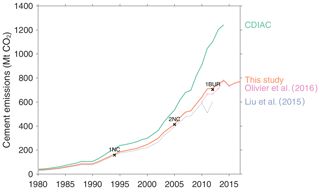
Figure 3Process emissions from Chinese cement production, 1980–2017. 1NC refers to China's first National Communication, 2NC the second National Communication, and 1BUR the first Biennial Update Report. Also shown are estimates from CDIAC (Boden et al., 2017), Liu et al. (2015) and EDGAR v4.3.2 FT2015.
For China, emissions reached just under 800 Mt CO2 in 2014 (Fig. 3). The emissions estimated here show high agreement with the few official estimates reported, a direct consequence of our use of official data and emission factors. While China produced 57 % of the world's cement in 2017, its emissions were 52 % of the total, a consequence of its clinker ratio being less than 0.60 in recent years, below the world average. The rebound in Chinese cement production, and therefore emissions, is the main reason for global emissions to have regained the level of 2014. Results for a number of other countries are presented in the Appendices.
Indian emissions are quite uncertain, but the methods used here produce results reasonably close to the few officially reported estimates (Fig. 4). In 2010 there is some divergence from the estimate in India's first Biennial Update Report. In that year the data provided by the Indian Cement Manufacturers' Association are known to be incomplete, while other data sources indicate substantially higher clinker production in that year; this discrepancy is yet to be resolved (see Appendix D).
Aggregate uncertainty is relatively low through most of the historical period (Fig. 2, top panel), partly as a direct consequence of the choice of the Monte Carlo method with symmetric distributions and no correlation: errors tend to cancel. In 1990, with the beginning of most Annex-I countries' detailed reporting to the UNFCCC, global uncertainty declines slightly, but then gradually increases as more cement production occurs in developing countries, where uncertainty is higher. Uncertainty increases sharply in 2017 because of the use of more provisional data.
A recent study estimated global cement carbonation (uptake of CO2 by concrete during its use and disposal phases) at about 900 Mt CO2 in 2013 (Xi et al., 2016), which would be about 63 % of emissions from cement production in that year. However, the central estimate (within a Monte Carlo uncertainty assessment) was based on the assumption that the global average clinker ratio was 0.75, the default suggested by the IPCC for countries with a significant proportion of blended cement production (Hanle et al., 2006). Interestingly, while the global clinker ratio appears to be substantially lower than 0.75, the important scaling factor in the estimate of carbonation is in fact the CaO content of the concrete, and use of clinker substitutes means that global carbonation could actually be higher rather than lower than the central estimate of Xi et al. (2016).
The main reason for the difference in the cumulative results presented here with those presented in the previous version of this “living data” article is the removal of double counting of the countries of the former Soviet Union.
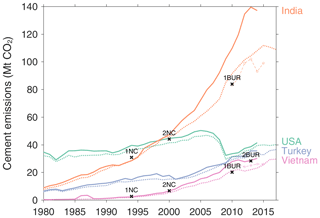
Figure 4Comparing new cement emissions estimates (dashed lines) for the top four cement producers after China with those from CDIAC (solid lines), and official estimates (crosses, India and Vietnam) as reported to the UNFCCC (see text). The new estimates for the USA and Turkey come directly from national official estimates. Estimates from EDGAR v4.3.2_FT2015 are shown for India and Vietnam with round markers.
All data used in producing this dataset, and the resulting dataset itself, are available on Zenodo at the following DOI: https://doi.org/10.5281/zenodo.831454.
The exception is the “Getting the Numbers Right” dataset from WBCSD, which is available from their website (WBCSD, 2014).
Estimating global process emissions from cement production is fraught with problems of data availability, and has always required strong assumptions. Over the last 3 decades, countries around the world have increasingly been producing blended cements, with lower clinker ratios, and the use of cement production data with constant emission factors has become untenable.
The new global cement emissions database presented here increases the reliance on official and reliable data sources, and reduces reliance on assumptions, compared with previous efforts. The database is used in the Global Carbon Budget for the first time in the 2018 edition, and the intention is that it will be updated annually, with both data updates and methodological improvements under the “living data” format. As more countries estimate their emissions and report them to the UNFCCC in detail, more data will replace assumptions in producing this dataset. Work is still required in improving estimates of cement emissions from both China and India, in particular, as these are the world's two largest cement producers and official time-series estimates are lacking.
Released annually, CDIAC's emissions estimates have been widely reported, including in the IPCC's Fifth Assessment Report (Ciais et al., 2013). However, recently there have been some questions raised about the accuracy of CDIAC's cement emissions estimates, particularly for China (e.g. Lei, 2012; Ke et al., 2013; Liu et al., 2015). According to Ke et al. (2013), CDIAC's estimates of cement emissions for China were 36 % higher than those obtained from an IPCC Tier 2 method for 2007, amounting to an “error” of 181 Mt CO2, noting that “CDIAC's relatively higher emission factor is equivalent to the assumption of a high clinker-to-cement ratio” (p. 175).
A1 Clinker ratios
The most obvious reason that CDIAC's estimates are higher than those produced elsewhere is that the formula they have used obscures an assumption about the ratio of clinker to cement in production.
CDIAC's method for estimating process emissions from cement production by country is taken from a report by Griffin (1987), and requires that cement production data in tonnes are multiplied by a fixed factor 0.136 to obtain tonnes of carbon emitted as CO2, i.e. 1 tonne of cement produced results in t CO2 (Boden et al., 1995).
According to Griffin (1987), the emissions factor for the production of cement, Ecem, from the calcination of limestone is given as follows:
where is the fraction of CaO in cement, is the molecular weight of CO2 (44.01), and is the molecular weight of CaO (56.08). Based on discussion with experts, Griffin (1987) recommended that , calculated as the midpoint of the range 0.60–0.67 given by Orchard (1973).
According to the IPCC's more recent 2006 guidelines (Hanle et al., 2006), when using cement production data adjusted for clinker trade, the formula should read as follows:
where is the clinker ratio, and is the fraction of CaO in clinker. In the earlier, 1996 IPCC guidelines, the information sourced from CDIAC stated that the average CaO content of cement is 0.635, while the CaO content of clinker is 0.646, yielding an implicit average clinker ratio of cement of 0.98.
This high implicit clinker ratio appears to be based on the assumption that the majority of cement produced in the world is ordinary Portland cement: “Other speciality cements are lower in lime, but are typically used in small quantities. …The differences between the lime content and production of clinker and cement, in most countries, are not significant enough to affect the emission estimates” (Haukås et al., 1997, p. 7; emphasis in original). Indeed, Orchard (1973) made his statement about lime content in reference to Portland cements, which are that type that is composed of at least 95 % clinker, rather than cement in general.
In the USA, the average clinker ratio was most likely about 0.95 for much of the twentieth century, possibly dropping to about 0.90 or slightly lower after about 1970 (Hendrik van Oss, USGS, personal communication, 2015). However, the International Energy Agency (IEA), recently estimated the global-average clinker ratio to be 0.65 (IEA, 2017), and the dataset presented in this work agrees with that assessment (Fig. A1). In China, where almost 60 % of cement is produced, the clinker ratio is currently below 0.60.
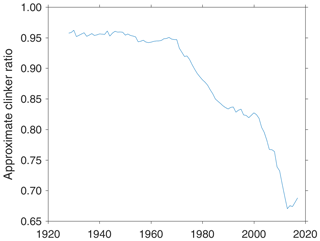
Figure A1Approximate implied global clinker ratio, derived from emissions estimates and cement production data using default emission factors. The trend up until 1990 is largely a result of the assumptions used in extrapolation, although in earlier years the data for the US and Europe dominate.
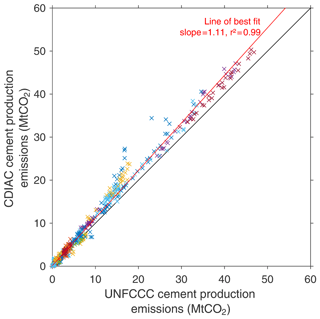
Figure A2Comparison of CO2 emissions in 43 countries as estimated by CDIAC (Boden et al., 2013) and those officially reported to the UNFCCC, 1990–2012 (UNFCCC, 2014).

Figure A3The Netherlands: (a) CDIAC vs. UNFCCC; (b) linker, cement. Note “Clinker consumption” is production plus imports less exports, but excludes stock changes. Sources: UNSD (2015), UNFCCC (2014), van Oss (1994–2018), and Boden et al. (2013).
WBCSD demonstrate that the clinker ratio has been declining in every region, and, based on the data they have available, the world average for 2012 was about 0.75. Furthermore, between 2000 and 2006 the clinker ratio decreased more quickly in developing countries than developed countries. WBCSD puts the primary reason for a lack of decline in developed countries as the acceptance of common practice and fixed product standards, which act as a barrier to reduction in clinker content. This is in contrast to, in particular, India and China, where fly ash from coal-fired power stations and slag from the iron and steel industry are widely used as clinker substitutes (WBCSD, 2009). Interestingly, it may simply be more common practice in developed countries for the construction industry to blend in other ingredients after the cement is made but before its use (AT Kearney, 2014).
A2 Use of cement production data
The best available data on CO2 emissions from cement production at a national level come from official submissions to the UNFCCC, with about 40 countries submitting annually (UNFCCC, 2017). Figure A2 compares CO2 emissions from CDIAC with those from UNFCCC specifically for the process of calcination. Over the 26-year period covered by the UNFCCC submissions (1990–2015), CDIAC's estimates are on average 11 % higher than those estimated by these countries. All countries reporting to the UNFCCC use clinker production data to estimate CO2 emissions.
CDIAC's estimates are produced using cement production data obtained from the USGS. However, according to the IPCC guidelines (Hanle et al., 2006, p. 10),
calculating CO2 emissions directly from cement production (i.e. using a fixed cement-based emission factor) is not consistent with good practice. Instead, in the absence of data on carbonate inputs or national clinker production data, cement production data may be used to estimate clinker production by taking into account the amounts and types of cement produced and their clinker contents and including a correction for clinker imports and exports. Accounting for imports and exports of clinker is an important factor in the estimation of emissions from this source.
There is clearly some noise around the line of best-fit comparing CDIAC's estimates to emissions reported to the UNFCCC, as shown in Fig. A2, such that simply adjusting estimates down by 11 % (implying an average clinker ratio of about 0.87 for these countries) would still leave considerable differences with official estimates for some countries. These deviations could be explained as the effects of varying clinker ratios and international trade of clinker. The more clinker is imported for cement production (or exported), the poorer cement production data become for the purpose of estimating cement emissions.
The Netherlands provides a clear example of how poor the use of cement production data and a global-average clinker ratio can be. CDIAC's emissions estimates are at least double those reported to the UNFCCC, and as much as four times as high (Fig. A3a). The reason for this is because of significant net imports of clinker and a particularly low clinker ratio (Fig. A3b). The low clinker ratio is because most of the country's production is of cement type CEMIII, which is specifically suitable for use in marine conditions (CEMBUREAU, 2013), and this type of cement uses a much lower clinker ratio (European standard 197-1).
A3 System boundaries
As has been identified by others, one of the reasons for divergences between estimates of cement emissions is that different system boundaries have been used (e.g. Shen et al., 2014; Ke et al., 2013). Studies vary on whether they include process emissions from clinker production, other process emissions, direct fuel combustion emissions, and emissions from generation of purchased electricity. The IPCC guidelines clearly delineate types of emissions, and process emissions from clinker production are allocated to the Industrial Processes and Product Use (IPPU) sector, while emissions from electricity generation or direct fuel combustion by clinker producing firms are allocated to the energy “sector” (Eggleston et al., 2006). Sometimes lime is produced and mixed with clinker, and emissions from this process are also allocated to the IPPU sector, but listed separately from cement emissions.
It is not widely understood that CDIAC's emissions estimates do not follow the IPCC delineations, and instead CDIAC estimates emissions resulting from all oxidation of fossil fuels plus those from cement production (Boden et al., 1995; Marland and Rotty, 1984; Andres et al., 2012). Therefore, CDIAC's estimates of emissions from coal oxidation include non-energy use of coal, such as when used for anodes in aluminium production, in contrast to the IPCC methodology. CDIAC's system boundary is therefore much broader than generally understood, including not only all energy emissions but also most industrial process emissions.
In this work, historical cement production data in tonnes are sourced from CDIAC's cement emissions data. Because CDIAC use a constant emission factor based on cement production, reverse calculation of cement production data is straightforward. Those production data originally came from USGS (formerly Bureau of Mines; Marland and Rotty, 1984). This is significantly less time-consuming than replicating CDIAC's work of assembling USGS's various datasets.
C1 Annex I parties to the UNFCCC
The following countries report annual emissions inventories to the UNFCCC
using the Common Reporting Framework (CRF), and these were downloaded on
25 April 2018, except for Ukraine whose data were downloaded on 24 May 2018.
UNFCCC parties sometimes submit revisions through the year, and the specific
date of each country's submission as used in this study is shown
below:
Australia, 13 April 2018: Austria,
10 April 2018; Belgium, 13 April 2018; Bulgaria, 13 April 2018; Belarus,
6 April 2018; Canada, 9 April 2018; Switzerland, 16 April 2018; Cyprus,
11 April 2018; Czech Republic, 6 April 2018; Germany,
4 April 2018; Denmark, 14 April 2018; Spain, 2 April 2018;
Estonia, 13 April 2018; Finland, 6 April 2018; France, 12 April 2018; United
Kingdom, 16 April 2018; Greece, 4 April 2018; Croatia, 27 March 2018;
Hungary, 13 April 2018; Ireland, 12 April 2018; Iceland, 12 April 2018;
Italy, 12 April 2018; Japan, 18 April 2018; Kazakhstan, 23 April 2018;
Liechtenstein, 9 April 2018; Lithuania, 13 April 2018; Luxembourg,
4 April 2018; Latvia, 12 April 2018; Malta, 11 April 2018; Netherlands,
10 April 2018; Norway, 13 April 2018; New Zealand, 10 April 2018; Poland,
9 April 2018; Portugal, 2 April 2018; Romania, 16 April 2018; Russia,
13 April 2018; Slovakia, 26 March 2018; Slovenia, 13 April 2018; Sweden,
11 April 2018; Turkey, 13 April 2018; Ukraine, 22 May 2018; United States of
America, 12 April 2018.
These inventories explicitly state process emissions from cement production from 1990 onwards (IPCC sector 2A1). The 2018 submissions include emissions data up to 2016. Monaco's emissions have been combined with those of France, following CDIAC.
Figure C1 compares cement emissions for Annex-I parties as reported by CDIAC (Boden et al., 2017) with those reported here1.
C2 China
As by far the largest producer of cement worldwide, estimating China's emissions from cement production is critical to having a robust global estimate. In 1982 China overtook Japan to become the world's largest producer of cement and in 2017 accounted for about 57 % of global production (Fig. C2).
China has released several official estimates of process emissions from cement production in reporting to the UNFCCC. In its first National Communication to the UNFCCC, China reported (p. 32) process emissions from cement production of 157.8 Mt CO2 in 1994 from about 300 Mt clinker (SDPC, 2004). In its second National Communication, China reported (p. 59) 411.7 Mt CO2 in 2005 from about 765 Mt2 of clinker (NDRC, 2012, 2014). Finally, in its first Biennial Update Report, China does not report emissions from cement production separately, but does report3 clinker production of 1303.9 Mt in 2012 (NDRC, 2016), which, with China's emission factor of 0.5383, would have led to about 702 Mt CO2. In all three cases, China has used firm-level surveys to determine the emission factor.
In 2016 the China Cement Association's (CCA) annual Cement Almanac 2015 presented much lower historical clinker production for some years than previous editions (CCA, 2016, in Chinese). These are not revisions, but a change in the coverage of the data presented: previous almanacs presented national totals, while the 2015 edition presents production from enterprises with revenues over a specified threshold (so-called “above-sized” enterprises; a correspondent at CCA, personal communication, 2017). The differences between these two figures has diminished considerably over time, such that clinker production from above-size enterprises in 2013 was 98 % of all clinker production reported by CCA in the previous edition.
National clinker production data for 1990–2004 were provided by Shaohui Zhang, who received them directly from CCA (Zhang et al., 2015); 2005–2013 are from the 2015 edition of CCA's almanac; 2014–2017 are from NBS via the China Cement Research Institute (CCRI), and these have been scaled up very slightly so that the 2013 figure matches the national total provided by CCA.
Figure C3 shows clinker ratios (the ratio of clinker production to cement production) from this and a number of other sources. Some authors do not adjust for clinker trade before calculating the ratio. The numbers from WBCSD are unreliable because of a very small sample size in China (∼4 % of all clinker production), likely to be biased to producers of higher-quality cement.
The clinker ratio in China has been below 0.8 since at least 1990, and has declined rapidly in the last decade to about 0.62 in recent years (Fig. C3). Along with the use of clinker substitutes mentioned above, the use of modern kiln types also contributes to lowering clinker requirements. The New Suspension Preheater (NSP) type, which allows lower clinker ratios to be used in cement production given the same strength requirements, was used for about one-seventh of production in 2000, a share which had grown to about four-fifths in 2010 (Xu et al., 2012).
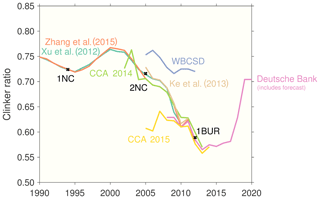
Figure C3China's clinker ratio since 1990, from a number of different sources. The three official estimates are marked in black: 1NC is the first National Communication, 2NC the second National Communication, and 1BUR is the first Biennial Update Report.
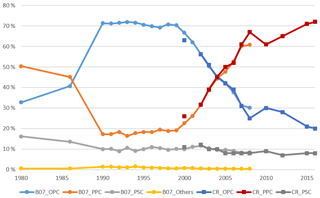
Figure C4Proportions of cement production by type. B07: Bapata et al. (2007), CR: CRISIL (https://www.crisil.com/, last access: 31 March 2017). OPC: ordinary Portland cement, PPC: Portland pozzolana cement, PSC: Portland slag cement.
The default factor for the average lime (CaO) content of clinker given by the IPCC 2006 guidelines is 65 %. Liu et al. (2015) used 62 %, being the weighted average derived from the factory-level study made by Shen et al. (2014)4. However, clinker production also involves the decomposition of Mg CO3 to MgO, and emission factors derived only from the CaO content (including Liu et al., 2015) omit this source of CO2 emissions, which Annex-I parties include in their inventories.
China's second National Communication used emission factors “derived from in situ surveys” (p. 60), while the first Biennial Update Report used factors “obtained through typical enterprise survey” (p. 19). The factor used for the second National Communication is provided in the NDRC's report: 0.5383 (NDRC, 2014). This factor excludes clinker kiln dust, stated to be negligible, but does include emissions from the decomposition of Mg CO3.
For years before 1990, the assumption is made here that the clinker ratio was 0.8 until 1970, and then linearly declined to the estimated value in 1990.
The cement emissions derived in this study are shown in Fig. 3, which also compares with several other available estimates. The 2011 dip in cement emissions presented by Liu et al. (2015) appears to be spurious, based on an unlikely low clinker ratio of 0.49 in that year. Recent data from CCA indicate a ratio of 0.63 in that year, with no particular discontinuity.
C3 India
India is the second-largest producer of cement in the world, with about 270 000 t in 2017 (USGS, 2018). The 47 % of India's cement production covered by WBCSD's data used a clinker ratio of 0.70 in 2014 (WBCSD, 2012).
In India's first National Communication to the UNFCCC, with data for 1994, process emissions from cement production are reported as 30 767 kt CO2, using an emission factor of 0.537 t CO2 (t clinker)−1 (p. 41), implying clinker production of 57 294 kt in that year (Ministry of Environment & Forests, 2004). USGS reports Indian cement production in that year as 57 000 kt. Allowing for rounding, the implied clinker ratio was therefore surprisingly high at approximately 1.0 in 1994. WBCSD data indicate that the clinker ratio in 1990 was 87 % for the cement manufacturers from which they had data (WBCSD, 2014). These data are inconsistent, but it is unclear where the error lies.
Similarly, in India's second National Communication, with data for 2000, process emissions are reported as 44 056 kt CO2, using the same emissions factor (p. 53), implying clinker production of 82 041 kt (Ministry of Environment & Forests, 2012). USGS reports cement production in 2000 of 95 000 kt. The clinker ratio was therefore most likely about 0.86 in 2000, agreeing closely with that reported by WBCSD (0.85).
India's first Biennial Update Report reports cement process emissions of 83 851.74 kt CO2 in 2010 (Ministry of Environment Forest and Climate Change, 2015). Energy emissions were reported to have been about the same as in 2000 implying vastly improved efficiency. The BUR does not indicate what emission factor they have used, but assuming 0.537 as before would suggest 156 Mt clinker production in 2010.
With no complete official time-series of either clinker production or clinker ratio, a multi-source approach has been used here. We make use of data from the Indian Cement Manufacturers' Association (CMA), consultancy reports from CRISIL and IBEF, WBCSD, and other sources. Data include clinker production, blending ratio (the inverse of clinker ratio), and cement types. When calculating clinker ratios from clinker and cement production data, clinker trade has been taken into account.
The cement-type data (Fig. C4) indicates a dramatic shift to OPC, between 1986 and 1990, suggesting an improvement in quality. This appears to have been a result of “decontrol” in 1989, which removed many regulations from the industry. Since 2000 the cement types have begun to change again, a result of growing acceptance of other types of cement as being of sufficient quality (CRISIL, 2017, p. 20).
Using the cement types, combined with the proportion of clinker in each cement type, one can derive the overall clinker ratio from a weighted average. The proportions of clinker in each cement type change over time, and only two sets of estimates were available: one from the WBCSD and IEA (2013), assumed to represent 2012 and later, and another from IBEF (2005), assumed to represent 2005 and earlier. The clinker ratios by cement type were interpolated linearly between these 2 years.
The WBCSD survey data for India cover close to half of Indian cement manufacture. These data show that the clinker ratio has declined from 0.86 in 1990 to 0.70 in 2014.
Various reports on the Indian cement industry by consultancy CRISIL give data on both clinker production and blending ratio for various years.
The CMA also provides clinker production data, but in the 2009–2010 financial year two members discontinued their membership of the association, so production data from that year onwards are incomplete (CMA, 2010).
There unfortunately remains some disagreement between the clinker ratios derived from different sources (Fig. C5). The data from the WBCSD represent just under half of cement production in India, most likely the larger producers. There is a significant divergence in 2009/2010 between WBCSD and the other data sources. CRISIL reports that “the blending ratio dipped significantly to around 1.25 from 1.34 in 2008–2009. Cement players had lowered the blending ratio during the year on account of decline in cement demand and increased clinker production.” (CRISIL, 2013, p. A-19). The cement-type data also show a sharp increase against the trend in the amount of OPC produced at that time, from 25 % in 2007–2008 to 30 % in 20 October 2009. It may be that the survey-based approach of WBCSD did not capture this adjustment in the industry.
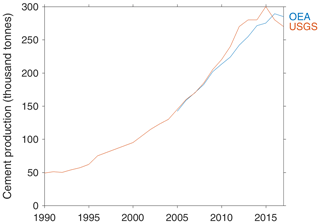
Figure C6Comparison of Indian cement production data from USGS and OEA, the latter beginning in 2005.
The use of clinker production data is clearly preferred. When clinker production data were not available in earlier years, we have used the analysis based on cement types. In later years we use the reported blending ratios (reciprocal of the clinker ratio). Data were adjusted from financial to calendar years by using monthly cement production data.
The clinker ratio must be applied to cement production data, but there is some divergence between USGS data and those from the Office of the Economic Advisor (OEA), which are reported by the CMA (Fig. C6). This divergence has not yet been explained. In this work we rely on the official data from the OEA, although this only affects the emissions estimate after 2016, because clinker production estimates are used for 2004–2015.
Indian analyses have shown emission factors (t CO2 (t clinker)−1) similar to the default IPCC factor of 0.52 (Arceivala, 2014), so we use that factor here.
The final emissions time-series lies very close to the three available official estimates (Fig. C7).
C4 USA
The USA reports annual emissions from cement production to the UNFCCC, along with all other Annex-I parties. However, in addition to this series, which starts in 1990, the US Geological Survey (USGS) have an unpublished time series of clinker production in the US starting in 1925 (Hendrik van Oss, USGS, personal communication, 2015). These allow very good estimates of CO2 emissions from historical clinker production. Furthermore, while USGS clinker data begin in 1925, the clinker ratio was very close to 1 between 1925 and 1970. By assuming that it was also 1 between 1900 and 1924, the data series can be extended back to 1900, when cement production data begin (Fig. C8).
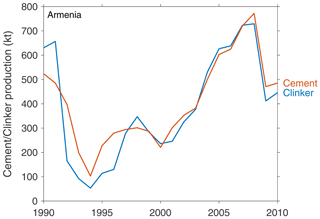
Figure C10Clinker and cement production in Armenia, 1990–2010 (Ministry of Nature Protection, 2014; van Oss, 1994–2018).
Until about 1970, CDIAC's estimates of US cement emissions show good correspondence with estimates calculated directly from clinker production data. However, after about 1970 significant deviations appear as the clinker ratio of US cement began to drop below unity (Fig. C8). The same method is used here to calculate emissions from clinker production data as is used in the US National Inventory Report. The reason for the divergence seen in Fig. C8 is that the UNFCCC submission includes cement production in Puerto Rico, while the estimates in this study do not.
C5 Armenia
Armenia's 2010 National Inventory Report provides emissions from cement production for 1990–2010 (Ministry of Nature Protection, 2014). The implied emission factor is nearly constant, at around 0.507 every year. The second National Inventory Report for 2012 provides emissions for 2000–2012, now using Tier III methodology (Ministry of Nature Protection, 2015). These have been combined with the earlier estimates to give a longer data series from 1990 to 2012. The introduction of Tier III methodology raised emissions in the overlapping period by an average of 14 %, and this was used to adjust the emissions from the first NIR.
Armenia's clinker production was significantly higher than USGS-reported cement production in 1990 and 1991, indicating significant exports or stockpiling of clinker in those years (Fig. C10). While clinker production dropped significantly below cement production in the following few years, there have been a number of years since when clinker appears to have been exported.
While it is quite possible that Armenia was a net exporter of clinker in years prior to 1990, no data have been found to substantiate this. After 2012 we assume that the ratio of clinker production and cement production in 2012 continue, with the emission factor of 2012.
C6 Azerbaijan
Azerbaijan's third National Communication provides estimates of emissions from cement production for 1990, 2000, and 2005–2012.
C7 Bosnia and Herzegovina
Bosnia-Herzegovina's second Biennial Update Report includes a chart showing estimates of cement emissions for 2002–2013, and specific estimates are provided in the text for 2003 and 2012.
C8 Brazil
Brazil's third National Communication to the UNFCCC includes estimates of emissions from cement production from 1990 to 2010 (MSTI, 2016). The emission factor ranges between 0.544 and 0.549 t CO2 (t clinker)−1, for the years where clinker production data are provided. The clinker ratio (assuming zero clinker trade) has declined from 0.78 in 1990 to 0.66 in 2010 (Fig. C14).
The report states that Brazil has been substituting clinker in cement manufacture “for over 50 years” (p. 100). For years before 1990, clinker ratio was interpolated linearly between 0.95 in 1965 to the estimated ratio in 1990 from the data. After 2010, the clinker ratio was assumed constant at the 2010 level.
C9 Chile
The Chilean National Inventory Report (MdMA, 2017) presents clinker production data for 1990–2013, with 1990–1994 and 2013 estimated based on extrapolated clinker ratios. The country uses IPCC default emission factors in the absence of country-specific data. Significant imports of clinker mean that the resulting emissions are significantly lower than those estimated by CDIAC (Fig. C15).
Imports were negligible in 1990, so an assumption has been made of no imports prior to 1990. For years after 2013, the ratio of clinker production to cement production has been assumed to continue, implicitly assuming the same clinker ratio and clinker trade ratios.
C10 Colombia
Colombia's first Biennial Update Report includes a chart showing estimates of cement emissions for 1990, 1994, 2000, 2004, 2010 and 2012.
C11 Indonesia
Indonesia's first Biennial Update Report provides estimates of process emissions from cement production for 2000–2012, using the IPCC default emission factor. Clinker production is higher than cement production in many years.
The clinker ratio, even after adjustment for clinker trade, is still above unity in some years, which is impossible (Fig. C20). This uses cement production data from USGS. Clearly there are some inconsistencies in the datasets used, and without clinker production data it appears impossible to extrapolate a reasonable time series of cement emissions for Indonesia.
C12 Israel
Israel's third National Communication provides estimates of emissions from cement production for 1996, 2000, and 2003–2015.
C13 Jamaica
Jamaica's first Biennial Update Report presents clinker production and emissions estimates for 2006–2012 (Mahlung and Dore, 2016). The implied emission factor used is 0.520 kg CO2 (kg clinker)−1.
The BUR states that clinker production data were obtained from the Caribbean Cement Company. Accordingly, further clinker production data have been sourced from annual reports of the Caribbean Cement Company (Caribbean Cement Company, various years) to extend this series to 1995–2016 (Fig. D22).
The clinker ratio was 0.96 in 1995. For years before 1995, a clinker ratio of 0.95 has been assumed with the same emission factor of 0.520.
C14 Korea
The Korea Cement Association (KCA) publishes annual national clinker and cement production from 1991, and at the time of writing data were available to 2016.
The third National Communication (Korean Ministry of Environment, 2012) states that cement production was 40.9 % of total industrial process emissions of 56.7 Mt CO2 in 2009, which comes to 23.19 Mt CO2. Using an emission factor of 0.52 and the KCA clinker production figure of 44.774 Mt gives a very close 23.28 Mt CO2 (Fig. C23).
The clinker ratio over 1991–2015 from the KCA data show no clear trend, varying from year to year probably only in response to clinker trade (Fig. C24).
C15 Lebanon
Lebanon's second Biennial Update Report provides estimates of cement emissions for the years 1994, 2000, 2006, 2011 and 2013.
C16 Mexico
Mexico's first Biennial Update Report (INECC and Semarnat, 2015) provides CO2 emissions from cement manufacture 1990–2012 (Fig. C26). Mexico has had significant clinker exports over this period, such that emissions are in many years higher than the estimates made by CDIAC.
After 2012, the emissions rate was assumed constant at the 2012 level, implicitly assuming constant clinker ratio and international clinker trade.
C17 Moldova
Moldova's National Inventory Report provides cement emissions for 1990–2012 (Ministry of Environment, 2013). Clinker production tracked cement production relatively closely over the entire period, although cement production was rather higher than clinker production in 1990, suggesting either exports of clinker or lower clinker ratio in that year (Fig. C28).
After 2010 we assume that the ratio of clinker production and cement production in 2010 continue, with the emission factor of 2010 (Fig. C27).
The main reason GCB2016 estimates were so low is that the method used to disaggregate emissions from countries of the Soviet Union assumed that the shares in 1992 represented the shares before 1992.
C18 Mongolia
Mongolia's 2017 National Inventory Report provides cement emissions estimates for 1990–2014. The report also states that the first cement plant in Mongolia began operation in 1968.
C19 Morocco
Morocco's first Biennial Update Report provides estimates of cement emissions for 1994, 2000, 2005, 2006, 2008, 2010, and 2012.
C20 Namibia
Namibia's second National Inventory Report provides estimates for emissions from cement production for 2000–2012, and clearly states that there was no cement production in the country before 2011.
C21 Saudi Arabia
The Saudi cement company Yamama Cement publishes national statistics of clinker and cement production (Yamama Cement, 2018). Cement production statistics from USGS are largely consistent, with some exceptions, particularly USGS's most recent estimates for 2016 and 2017 (Fig. C32). The Saudi cement market is currently characterised by significant overproduction of clinker, with large stockpiles accumulating.
Saudi Arabia's three National Communications and first Biennial Update Report provide point estimates for cement emissions, but when compared with clinker production data, the latter two suggest very high emission factors or disagreement in activity data (Fig. C33). Neither the National Communications nor the Biennial Update Report provide any information on how emissions were calculated.
C22 Serbia
Serbia's second National Communication provides estimates of emissions from cement production for 1990, 2000, 2005 and 2010–2014.
C23 South Africa
South Africa's first National Inventory Report (2014) provides estimates of emissions from cement production for 2000–2010.
C24 Togo
Togo's first Biennial Update Report provides clinker production data and estimates of emissions from cement production for 1995–2015 (Ministry for the Environment and Forest Resources, 2017).
C25 Uzbekistan
Uzbekistan's National Inventory Report includes a time series of cement emissions for 1990–2012 (Uzhydromet, 2016).
After 2012, the emission factor and clinker ratio of 2012 were assumed constant (Fig. C37).
Our uncertainty analysis leans heavily on the officially estimated uncertainty of cement emissions provided in submissions to the UNFCCC, whether in National Inventory Reports, National Communications, or Biennial Update Reports. These uncertainties, which follow the methods outlined in the IPCC's guidelines (Eggleston et al., 2006), represent 2 SD of a normal distribution (95 %). For countries without official estimates of uncertainty, estimates have been made based on the approaches used and other information. The greatest uncertainty is when only cement production data and average clinker ratios have been used, and for these cases the uncertainty (2 SD) has been set at 25 %. See the accompanying uncertainty dataset for details.
We have also allowed uncertainty to vary by time, with much higher uncertainties outside of the time covered by official estimates. For example, Annex-I countries report emissions for 1990–2016, while outside of that period clinker ratios and cement production data have been used with higher uncertainty.
The uncertainty estimates by country and by time are used in a Monte Carlo analysis with 10 000 runs to give estimates of uncertainty for global cement emissions. This method effectively uses combined uncertainty of all underlying factors, such as method, clinker ratios, emission factors, cement kiln dust factors, and so on.
Uncertainties are assumed to be uncorrelated between countries and across time. The later assumption means that the uncertainty of any derived growth rates would be overestimated.
The results of the uncertainty analysis at the global level are shown in the main text, Fig. 2.
The author declares that they have no conflict of interest.
Valuable assistance in this work was received from Hendrik van Oss of the US
Geological Survey. Shaohui Zhang of IIASA provided historical clinker and
cement production data provided to him directly by the Chinese Cement
Association. Chen Pan of Nanjing University assisted with gathering
additional data and information from Chinese sources. Gregg Marland of
Appalachian State University provided the report by Griffin. Funding for the
first version of this article was provided by CICEP – Strategic Challenges
in International Climate and Energy Policy (Research Council of Norway grant
number 209701). The assistance of Robert Gieseke is appreciated. This work
builds on the legacy of CDIAC, especially the work of Gregg Marland,
Robert Andres, and Tom Boden. The comments of several anonymous referees
contributed to improving this paper.
Edited by: David Carlson
Reviewed by: two anonymous referees
Andres, R. J., Boden, T. A., Bréon, F.-M., Ciais, P., Davis, S., Erickson, D., Gregg, J. S., Jacobson, A., Marland, G., Miller, J., Oda, T., Olivier, J. G. J., Raupach, M. R., Rayner, P., and Treanton, K.: A synthesis of carbon dioxide emissions from fossil-fuel combustion, Biogeosciences, 9, 1845–1871, https://doi.org/10.5194/bg-9-1845-2012, 2012.
Andrew, R. M.: Global CO2 emissions from cement production, Earth Syst. Sci. Data, 10, 195–217, https://doi.org/10.5194/essd-10-195-2018, 2018.
Arceivala, S. J.: Green technologies for a better future, McGraw Hill, New Delhi, 2014.
AT Kearney: Cement Vision 2025: Scaling New Heights, available at: https://www.atkearney.in/ (last access: 23 June 2017), 2014.
Bapata, J. D., Sabnisb, S. S., Joshic, S. V., and Hazaree, C. V.: History of Cement and Concrete in India – A Paradigm Shift, American Concrete Institute (ACI) Technical Session on History of Concrete, Atlanta, USA, April 2007, 2007.
Baxter, M. S. and Walton, A.: A Theoretical Approach to the Suess Effect, Proc. R. Soc. Lon. Ser.-A, 318, 213–230, https://doi.org/10.1098/rspa.1970.0141, 1970.
Boden, T. A., Marland, G., and Andres, R. J.: Estimates of Global, Regional, and Naitonal Annual CO2 Emissions from Fossil-Fuel Burning, Hydraulic Cement Production, and Gas Flaring: 1950–1992, Carbon Dioxide Information Analysis Center (CDIAC), Oak Ridge National Laboratory, Oak Ridge, Tennessee, available at: https://cdiac.ess-dive.lbl.gov/epubs/ndp/ndp030/ndp0301 (last access: 28 June 2017), 1995.
Boden, T. A., Marland, G., and Andres, R. J.: Global, Regional, and National Fossil-Fuel CO2 Emissions, Carbon Dioxide Information Analysis Center, Oak Ridge National Laboratory, U.S. Department of Energy, Oak Ridge, Tenn., USA, https://doi.org/10.3334/CDIAC/00001_V2013, 2013.
Boden, T. A., Andres, R. J., and Marland, G.: Global, Regional, and National Fossil-Fuel CO2 Emissions, Carbon Dioxide Information Analysis Center, Oak Ridge National Laboratory, U.S. Department of Energy, Oak Ridge, Tenn., USA, available at: https://cdiac.ess-dive.lbl.gov/trends/emis/meth_reg.html, (last access: 1 August 2013), 2017.
BP: BP Statistical Review of World Energy June 2018, available at: https://www.bp.com/en/global/corporate/energy-economics/statistical-review-of-world-energy.html, last access: 14 June 2018.
Caribbean Cement Company: Annual Report, available at: https://www.caribcement.com/investor-relations-2/, last access: 9 June 2017.
CCA: China Cement Almanac 2015, China Building Material Press, Beijing, 2016 (in Chinese).
CEMBUREAU: Cements for a low-carbon Europe, The European Cement Association, Brussels, available at: https://cembureau.eu/news-views/publications/cements-for-a-low-carbon-europe/ (last access: 6 May 2015), 2013.
Ciais, P., Sabine, C., Bala, G., Bopp, L., Brovkin, V., Canadell, J., Chhabra, A., DeFries, R., Galloway, J., Heimann, M., Jones, C., Quéré, C. L., Myneni, R. B., Piao, S., and Thornton, P.: Carbon and Other Biogeochemical Cycles, chap. 6, in: Climate Change 2013: The Physical Science Basis. Contribution of Working Group I to the Fifth Assessment Report of the Intergovernmental Panel on Climate Change, edited by: Stocker, T. F., Qin, D., Plattner, G.-K., Tignor, M., Allen, S. K., Boschung, J., Nauels, A., Xia, Y., Bex, V., And Midgley, P. M., Cambridge University Press, Cambridge, United Kingdom and New York, NY, USA, 2013.
CMA: Annual Report 2009–10, Cement Manufacturers' Association (India), available at: http://cmaindia.org/annual-report.html (last access: 28 April 2017), 2010.
CRISIL: Cement: Annual Review, available at: https://www.crisil.com/pdf/research/industry-research-sample-report.pdf (last access: 21 June 2017), 2013.
CRISIL: Cement: September 2017, New Delhi, available at: https://www.crisil.com/content/dam/crisil/our-analysis/reports/Research/premium-reports/sectors/september/Sector-Report-Cement-September-2017.pdf (last access: 12 January 2018), 2017.
CRISIL: Cement Industry Report, available at: https://www.crisil.com/, last access: 31 March 2017.
Eggleston, S., Buendia, L., Miwa, K., Ngara, T., and Tanabe, K. (Eds.): Guidelines for National Greenhouse Gas Inventories, Prepared by the National Greenhouse Gas Inventories Programme, Institute for Global Environmental Strategies, Hayama, Kanagawa, Japan, available at: https://www.ipcc-nggip.iges.or.jp/public/2006gl/index.html (last access: 21 May 2017), 2006.
Griffin, R. C.: CO2 release from cement production, in: Estimates of CO2 emissions from fossil fuel burning and cement manufacturing based on the United Nations energy statistics and the U.S. Bureau of Mines cement manufacturing data, edited by: Marland, G., Boden, T. A., Griffin, R. C., Huang, S. F.,Kanciruk, P., and Nelson, T. R., Oak Ridge National Laboratory, Oak Ridge, Tennessee, 1987.
Hanle, L., Maldonado, P., Onuma, E., Tichy, M., and van Oss, H. G.: Mineral Industry Emissions, in: 2006 IPCC Guidelines for National Greenhouse Gas Inventories, edited by: Eggleston, S., Buendia, L., Miwa, K., Ngara, T., and Tanabe, K., IGES, Japan, available at: https://www.ipcc-nggip.iges.or.jp/public/2006gl/index.html (last access: 21 May 2017), 2006.
Haukås, H. T., Jaques, A., Neitzert, F., Rosland, A., Rypdal, K., and Weidemann, F.: Industrial Processes, chap. 2, in: Revised 1996 IPCC Guidelines for National Greenhouse Gas Inventories: Reference Manual, edited by: Houghton, J. T., Meira Filho, L. G., Lim, B., Tréanton, K., Mamaty, I., Bonduki, Y., Griggs, D. J., and Callander, B. A., IPCC/OECD/IEA, Paris, available at: https://www.ipcc-nggip.iges.or.jp/public/gl/invs1.html (last access: 27 October 2014), 1997.
IBEF: Cement, India Brand Equity Foundation (report prepared by CRISIL), available at: https://www.ibef.org/download/Cement.pdf (last access: 27 April 2017), 2005.
IEA: Energy Technology Perspectives 2016: Towards Sustainable Urban Energy Systems, International Energy Agency, Paris, ISBN 978-92-64-25233-2, available at: https://www.iea.org/etp2016/ (last access: 8 September 2014), 2016.
IEA: Energy Technology Perspectives 2017: Catalysing Energy Technology Transformations, International Energy Agency, Paris, ISBN: 978-92-64-27597-3, available at: https://www.iea.org/etp2017/ (last access: 19 June 2017), 2017.
INECC and Semarnat: Primer Informe Bienal de Actualización Ante la Convención Marco de las Naciones Unidas Sobre el Cambio Climático, Instituto Nacional de Ecología y Cambio Climático (INECC) and Secretaría de Medio Ambiente y Recursos Naturales (Semarnat), Mexico City, Mexico, 2015.
Janssens-Maenhout, G.: Main differences in greenhouse gas emissions between EDGAR 4.1 and version 4.0, Joint Research Centre, European Commission, Ispra, Italy, available at: http://edgar.jrc.ec.europa.eu/Main_differences_between_EDGAR_version_41and40.pdf (last access: 21 November 2017), 2010.
Janssens-Maenhout, G., Crippa, M., Guizzardi, D., Muntean, M., Schaaf, E., Dentener, F., Bergamaschi, P., Pagliari, V., Olivier, J. G. J., Peters, J. A. H. W., van Aardenne, J. A., Monni, S., Doering, U., and Petrescu, A. M. R.: EDGAR v4.3.2 Global Atlas of the three major Greenhouse Gas Emissions for the period 1970–2012, Earth Syst. Sci. Data Discuss., https://doi.org/10.5194/essd-2017-79, 2017.
KCA: Annual production of clinker and cement (in Korean), Korea Cement Association, available at: http://www.cement.or.kr/stati_2015/yy_pro_view_page.asp?sm=2_3_1, last access: 23 April 2018.
Ke, J., McNeil, M., Price, L., Khanna, N. Z., and Zhou, N.: Estimation of CO2 emissions from China's cement production: Methodologies and uncertainties, Energy Policy, 57, 172–181, https://doi.org/10.1016/j.enpol.2013.01.028, 2013.
Keeling, C. D.: Industrial production of carbon dioxide from fossil fuels and limestone, Tellus, 25, 174–198, https://doi.org/10.3402/tellusa.v25i2.9652, 1973.
Korean Ministry of Environment: Korea's Third National Communication under the United Nations Framework Convention on Climate Change, Seoul, available at: https://unfccc.int/ (last access: 26 April 2017), 2012.
Le Quéré, C., Andrew, R. M., Friedlingstein, P., Sitch, S., Pongratz, J., Manning, A. C., Korsbakken, J. I., Peters, G. P., Canadell, J. G., Jackson, R. B., Boden, T. A., Tans, P. P., Andrews, O. D., Arora, V. K., Bakker, D. C. E., Barbero, L., Becker, M., Betts, R. A., Bopp, L., Chevallier, F., Chini, L. P., Ciais, P., Cosca, C. E., Cross, J., Currie, K., Gasser, T., Harris, I., Hauck, J., Haverd, V., Houghton, R. A., Hunt, C. W., Hurtt, G., Ilyina, T., Jain, A. K., Kato, E., Kautz, M., Keeling, R. F., Klein Goldewijk, K., Körtzinger, A., Landschützer, P., Lefèvre, N., Lenton, A., Lienert, S., Lima, I., Lombardozzi, D., Metzl, N., Millero, F., Monteiro, P. M. S., Munro, D. R., Nabel, J. E. M. S., Nakaoka, S.-I., Nojiri, Y., Padin, X. A., Peregon, A., Pfeil, B., Pierrot, D., Poulter, B., Rehder, G., Reimer, J., Rödenbeck, C., Schwinger, J., Séférian, R., Skjelvan, I., Stocker, B. D., Tian, H., Tilbrook, B., Tubiello, F. N., van der Laan-Luijkx, I. T., van der Werf, G. R., van Heuven, S., Viovy, N., Vuichard, N., Walker, A. P., Watson, A. J., Wiltshire, A. J., Zaehle, S., and Zhu, D.: Global Carbon Budget 2017, Earth Syst. Sci. Data, 10, 405–448, https://doi.org/10.5194/essd-10-405-2018, 2018.
Lea, F. M. and Desch, C. H.: The chemistry of cement and concretes, Arnold and Co., London, 1940.
Lei, S.: Key opportunities to reduce emissions in China's cement industry, Joint workshop by MOST & IEA on carbon capture and storage: opportunities in energy-intensive industry, Beijing, China, 2012.
Liu, Z., Guan, D., Wei, W., Davis, S. J., Ciais, P., Bai, J., Peng, S., Zhang, Q., Hubacek, K., Marland, G., Andres, R. J., Crawford-Brown, D., Lin, J., Zhao, H., Hong, C., Boden, T. A., Feng, K., Peters, G. P., Xi, F., Liu, J., Li, Y., Zhao, Y., Zeng, N., and He, K.: Reduced carbon emission estimates from fossil fuel combustion and cement production in China, Nature, 524, 335–338, https://doi.org/10.1038/nature14677, 2015.
Mahlung, C. and Dore, C.: Biennial Update Report for Jamaica, Covering GHG Emissions for 2006–2012, Ministry of Economic Growth and Job Creation, Kingston, Jamaica, 2016.
Marland, G. and Rotty, R. M.: Carbon dioxide emissions from fossil fuels: a procedure for estimation and results for 1950–1982, Tellus B, 36, 232–261, 1984.
MdMA: Informe del Inventario Nacional de Gases de Efecto Invernadero de Chile, Serie 1990-2013. Versión 2.0, Departamento de Mitigación e Inventarios de Contaminantes Climáticos, División de Cambio Climático, Ministerio del Medio Ambiente, Santiago, Chile, 2017.
Ministry for the Environment and Forest Resources: Premier Rapport Biennal Actualise Togo, available at: https://unfccc.int/process/transparency-and-reporting/reporting-and-review-under-convention/biennial-update-reports-0, last access: 5 October 2017.
Ministry of Environment: National Inventory Report: Greenhouse Gas Sources and Sinks in the Republic of Moldova 1990–2010, Ministry of Environment of the Republic of Moldova, Chisinau, Moldova, available at: https://unfccc.int/process/transparency-and-reporting/reporting-and-review-under-the-convention/national-communications-non-annex-i-parties/submitted-national-communications-from-non-annex-i-parties (last access: 5 May 2017), 2013.
Ministry of Environment & Forests: India's Initial National Communication to the United Nations Framework Convention on Climate Change, available at: https://unfccc.int/process/transparency-and-reporting/reporting-and-review-under-convention/national-communications-0 (last access: 16 March 2017), 2004.
Ministry of Environment & Forests: India: Second National Communication to the United Nations Framework Convention on Climate Change, available at: https://unfccc.int/process/transparency-and-reporting/reporting-and-review-under-convention/biennial-update-reports-0 (last access: 13 March 2017), 2012.
Ministry of Environment Forest and Climate Change: India: First Biennial Update Report to the United Nations Framework Convention on Climate Change, available at: https://unfccc.int/process/transparency-and-reporting/reporting-and-review-under-convention/biennial-update-reports-0 (last access: 13 March 2017), 2015.
Ministry of Nature Protection: National Greenhouse Gas Inventory Report of the Republic of Armenia (2010), Yerevan, Armenia, available at: https://unfccc.int/process/transparency-and-reporting/reporting-and-review-under-the-convention/national-communications-non-annex-i-parties/submitted-national-communications-from-non-annex-i-parties (last access: 5 May 2017), 2014.
Ministry of Nature Protection: National Greenhouse Gas Inventory Report of the Republic of Armenia for 2012, Yerevan, Armenia, available at: https://unfccc.int/process/transparency-and-reporting/reporting-and-review-under-convention/biennial-update-reports-0 (last access: 5 May 2017), 2015.
Mohr, S. H., Wang, J., Ellem, G., Ward, J., and Giurco, D.: Projection of world fossil fuels by country, Fuel, 141, 120–135, https://doi.org/10.1016/j.fuel.2014.10.030, 2015.
MSTI: Third National Communication of Brazil to the United Nations Framework Convention on Climate Change, Brazilian Ministry of Science, Technology and Innovation, Brasilia, available at: https://unfccc.int/documents/66129, last access: 26 April 2016.
NDRC: Second National Communication on Climate Change of The People's Republic of China, National Development and Reform Commission, available at: https://unfccc.int/process/transparency-and-reporting/reporting-and-review-under-convention/national-communications-0 (last access: 24 April 2015), 2012.
NDRC: The People's Republic of China National Greenhouse Gas Inventory 2005, National Development and Reform Commission, Beijing, 2014.
NDRC: The People's Republic of China First Biennial Update Report on Climate Change, National Development and Reform Commission, Beijing, available at: https://unfccc.int/process/transparency-and-reporting/reporting-and-review-under-convention/biennial-update-reports-0 (last access: 24 March 2017), 2016.
Olivier, J. G. J., Bouwman, A. F., Berdowski, J. J. M., Veldt, C., Bloos, J. P. J., Visschedijk, A. J. H., van der Maas, C. W. M., and Zandveld, P. Y. J.: Sectoral emission inventories of greenhouse gases for 1990 on a per country basis as well as on , Environ. Sci. Policy, 2, 241–263, https://doi.org/10.1016/S1462-9011(99)00027-1, 1999.
Olivier, J. G. J., Janssens-Maenhout, G., Muntean, M., and Peters, J. A. H. W.: Trends in global CO2 emissions: 2016 report, PBL Netherlands Environmental Assessment Agency; Ispra: European Commission, Joint Research Centre, The Hague, available at: http://edgar.jrc.ec.europa.eu/news_docs/jrc-2016-trends-in-global-co2-emissions-2016-report-103425.pdf (last access: 26 October 2017), 2016.
Orchard, D. F.: Concrete Technology, Applied Science Publishers Ltd., London, 1973.
Rotty, R. M. and Marland, G.: Production of CO2 from fossil fuel burning by fuel type, 1860–1982, Carbon Dioxide Information Analysis Center (CDIAC), Oak Ridge National Laboratory, Oak Ridge, Tennessee, 1984.
SDPC: The People's Republic of China initial national communication on climate change, State Development Planning Commission, BeijingCHN/COM/1 E COPY 3 ENG, available at: https://unfccc.int/process/transparency-and-reporting/reporting-and-review-under-convention/national-communications-0 (last access: 4 April 2017), 2004.
Shen, L., Gao, T., Zhao, J., Wang, L., Wang, L., Liu, L., Chen, F., and Xue, J.: Factory-level measurements on CO2 emission factors of cement production in China, Renew. Sustain. Energy Rev., 34, 337–349, https://doi.org/10.1016/j.rser.2014.03.025, 2014.
UNFCCC: National Inventory Submissions 2014, United Nations Framework Convention on Climate Change, available at: https://unfccc.int/process/transparency-and-reporting/reporting-and-review-under-the-convention/greenhouse-gas-inventories/submissions-of-annual-greenhouse, last access: 28 May 2014.
UNFCCC: National Inventory Submissions 2017, United Nations Framework Convention on Climate Change, available at: https://unfccc.int/process/transparency-and-reporting/reporting-and-review-under-the-convention/greenhouse-gas-inventories/submissions-of-annual-greenhouse, last access: 1 May 2017.
UNFCCC: National Inventory Submissions 2018, United Nations Framework Convention on Climate Change, available at: https://unfccc.int/process/transparency-and-reporting/reporting-and-review-under-the-convention/greenhouse-gas-inventories-annex-i-parties/national-inventory-submissions-2018, last access: 24 May 2018.
UNSD: United Nations Commodity Trade Statistics Database (COMTRADE), available at: https://comtrade.un.org/, last access: 15 May 2015.
USGS: Cement statistics, in: Historical statistics for mineral and material commodities in the United States: U.S. Geological Survey Data Series 140, edited by: Kelly, T. D. and Matos, G. R., U.S. Geological Survey, available at: https://minerals.usgs.gov/minerals/pubs/historical-statistics (last access: 25 April 2017), 2014.
USGS: Mineral commodity summaries 2017, United States Geological Survey, Reston, Virginia, 202 pp., https://doi.org/10.3133/70140094, 2017.
USGS: Mineral commodity summaries 2018, United States Geological Survey, Reston, Virginia, 204 pp., https://doi.org/10.3133/70194932, 2018.
Uzhydromet: Inventory of Anthropogenic Emissions Sources and Sinks of Greenhouse Gases in the Republic of Uzbekistan, 1990–2012: National Report, Centre of Hydrometeorological Service, Tashkent, available at: http://unfccc.int/national_reports/non-annex_i_natcom/items/10124.php (last access: 5 May 2017), 2016.
van Oss, H. G.: Cement, in: Minerals Yearbook (various years), edited by: USGS, United States Geological Survey, available at: http://minerals.usgs.gov/minerals/pubs/commodity/cement/index.html (last access: 26 July 2018), 1994–2018.
van Oss, H. G.: Cement, in: 2014 Minerals Yearbook, edited by: USGS, United States Geological Survey, available at: http://minerals.usgs.gov/minerals/pubs/commodity/cement/index.html (last access: 12 January 2018), 2017.
WBCSD: The Cement Sustainability Initiative: Cement Industry Energy and CO2 Performance – “Getting the Numbers Right” World Business Council for Sustainable Development, available at: https://www.wbcsd.org/Sector-Projects/Cement-Sustainability-Initiative/Resources/Getting-the-Numbers-Right (last access: 30 April 2015), 2009.
WBCSD: Getting the Numbers Right project: Reporting CO2, World Business Council for Sustainable Development, available at: http://www.wbcsdcement.org/GNR-2012/index.html (last access: 29 March 2017), 2012.
WBCSD and IEA: Technology Roadmap: Low-Carbon Technology for the Indian Cement Industry, World Business Council for Sustainable Development and International Energy Agency, available at: https://webstore.iea.org/technology-roadmap-low-carbon-technology-for-the-indian- (last access: 23 March 2017), 2013.
WBCSD: Getting the Numbers Right project: Reporting CO2, World Business Council for Sustainable Development, available at: http://www.wbcsdcement.org/GNR-2014/index.html (last access: 29 March 2017), 2014.
Xi, F., Davis, S. J., Ciais, P., Crawford-Brown, D., Guan, D., Pade, C., Shi, T., Syddall, M., Lv, J., Ji, L., Bing, L., Wang, J., Wei, W., Yang, K.-H., Lagerblad, B., Galan, I., Andrade, C., Zhang, Y., and Liu, Z.: Substantial global carbon uptake by cement carbonation, Nat. Geosci., 9, 880–883, https://doi.org/10.1038/ngeo2840, 2016.
Xu, J.-H., Fleiter, T., Eichhammer, W., and Fan, Y.: Energy consumption and CO2 emissions in China's cement industry: A perspective from LMDI decomposition analysis, Energy Policy, 50, 821–832, https://doi.org/10.1016/j.enpol.2012.08.038, 2012.
Yamama Cement: Cement Statistics, available at: https://www.yamamacement.com/en/GeneralInformation/Pages/CementStatistics.aspx, last access: 26 July 2018 (in Arabic).
Zhang, S., Worrell, E., and Crijns-Graus, W.: Evaluating co-benefits of energy efficiency and air pollution abatement in China's cement industry, Appl. Energ., 147, 192–213, https://doi.org/10.1016/j.apenergy.2015.02.081, 2015.
- Abstract
- Introduction
- Previous estimates of global cement emissions
- Methods
- Results
- Data availability
- Conclusions
- Appendix A: Reasons for different estimates
- Appendix B: Cement production data
- Appendix C: Country-specific analyses
- Appendix D: Uncertainty analysis
- Competing interests
- Acknowledgements
- References
processemissions from cement production.
- Abstract
- Introduction
- Previous estimates of global cement emissions
- Methods
- Results
- Data availability
- Conclusions
- Appendix A: Reasons for different estimates
- Appendix B: Cement production data
- Appendix C: Country-specific analyses
- Appendix D: Uncertainty analysis
- Competing interests
- Acknowledgements
- References





